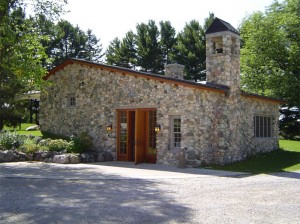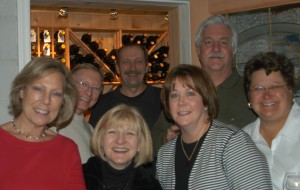
It all started innocently enough nearly thirty years ago. When I needed a “special” bottle of wine for a dinner or a gift, I’d stop into “Partners In Wine” and talk to Carl. He would listen to my needs, find out what was being served and recommend a bottle from his collection. Invariably, I would love his choices and return for a case of assorted wines to keep on hand in the basement (Carl gave a 10% discount on the purchase of a case). Soon, I had stacks of boxes full of wine I couldn’t get to. So I bought some storage racks. Before long, I had a half-dozen 4×12 free standing racks full of wine AND stacks of boxes. It was time for a new plan.
As luck would have it, our house has a block foundation that included a “storage closet” with a door that supports the front porch. It’s 3′ x 12′ and 8′ high. It had served only to hold unused paint and other “stuff” since we bought the house. I thought it would be ideal for a wine cellar. I also had another stroke of luck when I found a guy who had just purchased a house with a built in wine cellar that he didn’t want (he was a beer drinker). Armed with a screw driver and $150, I recovered three sections of nice redwood racking and a through-wall cooling unit. Turns out the cooling unit couldn’t be mounted through cinder block (not enough clearance) and remote cooling systems cost thousands of dollars, so my cellar was going to be “passive”, relying on constant earth temperature (and a lot of insulation) to maintain 55 degrees.
Once the room was clear, I made my final measurements and headed to the lumber store with a shopping list. I needed Styrofoam insulation, furring strips, and T&G cedar paneling. I wanted a nice 12×12 ceramic tile for the flooring. As with any project, I soon found I was back at Lowe’s to purchase an electric powered nail gun and a masonry hammer gun (the kind that shoots nails into concrete). I also selected miniature halogen track lighting and a motion detector to avoid fumbling for a switch in the dark.
The first step was to lay the tile flooring. The poured flooring was unpainted, so I troweled thin-set directly over the existing floor and laid three rows of 12×12 tile without having to cut a single one. After it set overnight, I grouted and cleaned it and was ready for step two.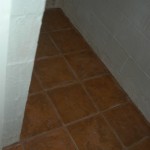
Step two was to apply a vapor barrier to the walls and ceiling to ensure the insulation would function properly and humidity could be maintained. This involved taping and stapling heavy gauge plastic sheeting over all the surfaces making sure to overlap and tape the seams at least a foot.
Step three was to anchor furring strips to the block wall to provide an anchor for the T&G paneling (this is where the hammer gun comes in handy). I also cut and taped 1″ Styrofoam into place between the furring strips on all the walls and ceiling.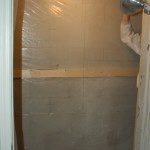
Installing the paneling is normally pretty straight forward. Measure, cut and nail. But, I decided to add character by applying 45 degree angles on the two cellar end walls. I used 1″x8″ cedar T&G on the back wall to make sure the racks would be secure and 1/2″x4″ T&G everywhere else. I finished it all off with quarter-round molding top and bottom and set the nails with a punch. I also finished the door jamb in cedar. Ready for racks.
The three sections of wine rack I had salvaged weren’t wide enough for the job. Luckily, I was able to locate a source on line that sold matching redwood kits that could be ordered in any size and style 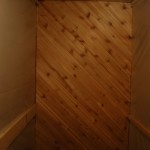 (this is where the electric nail gun came in handy). I added a center section of “X” shelves to accommodate multiple bottles of the same vintage and vineyard and complete the twelve foot run. It provides storage flexibility that looks appealing, too.
(this is where the electric nail gun came in handy). I added a center section of “X” shelves to accommodate multiple bottles of the same vintage and vineyard and complete the twelve foot run. It provides storage flexibility that looks appealing, too.
The original cellar had an overhead light fixture with a pull-chord switch. I removed it and installed the motion detector and miniature track lighting in its place. No other wiring modifications were needed. It works great. Open the door, walk in and the lights go on. They “time out” after about two minutes when you leave.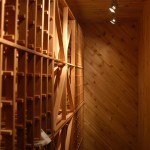
Finding the right door to finish off the cellar was critical. I wanted an insulated glass door to show off what was inside without letting in the heat or, letting out the cold. What I ended up with was even better. As we were loading up a “Plain Jane” double pane door at Fingerle’s Lumber, I noticed a very nice cut glass and soldered triple pane exterior door leaning against the wall of the shed. A quick measurement proved it could work with a little modification. So, I marched back into the store for a price. Turns out the door was a clearance special and cost much less than what I had originally selected. As you can see in the photo’s, it adds a nice statement to the cellar.
We’ve had the cellar (and it’s nearly 800 bottle capacity) for several years now. As a “passive” cellar, the temperature will vary somewhat, but it’s mostly in the mid-fifty degree range. We have seen it dip to 49 degrees when outdoor temperatures are near zero and spike to 63 degrees when it’s 90+ for extended periods outside, but these are extremes that we don’t see often. All in all, it’s been a fine addition to our passion for wine!

